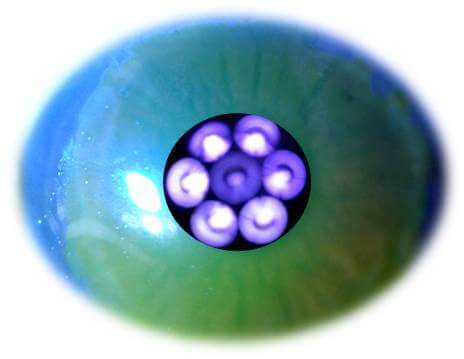
What is Corneal Collagen Crosslinking (CXL)?
The corneal collagen crosslinking procedure (CXL) is designed to decrease the progression of keratoconus.
Here at CLEI Center for Keratoconus, we have been performing crosslinking for over 15 years. Crosslinking is accomplished by instilling riboflavin drops onto the cornea and then exposing the cornea to ultraviolet A (UVA – 365nm) light.
In fact, our practice served as the medical monitor and Dr Hersh was the lead author of the two studies leading to the U.S. FDA approvals of corneal collagen crosslinking for keratoconus and corneal ectasia.
How Does CXL Work?
CXL aims to halt the keratoconus disease process by strengthening the cornea. The treatment results in mechanical stiffening of the cornea, with the clinical goal being a consequent decrease in the progression of the disease process.
Laboratory studies show that immediately after CXL, strength measurements increase in human corneas by over 300%. This occurs through a relatively complex photobiologic process. When activated with UVA light in the presence of oxygen, riboflavin is converted into excited singlet and triplet states, which then undergo a series of chemical reactions resulting in the formation of reactive species that interact with corneal proteins and lead to the formation of chemical bonds.
Several different pathways lead to the formation of crosslink bonds, driven by the relative availabilities of oxygen, riboflavin, and ultraviolet light. Under aerobic conditions, singlet oxygen and hydroxyl radicals are the reactive oxygen species (ROS) produced that react with the collagen to form these bonds.
Under anaerobic conditions, radical riboflavin may also lead to the production of crosslinking molecular bonds. Balancing the competing aspects of the reaction, by controlling the rate of oxygen consumption, allows for control of the distribution of crosslinking bonds formed in the cornea.
Although these biomechanical pathways may be complicated, CXL works simply by increasing corneal strength, and in our clinical trials appears to be effective in most patients to decrease the progression of keratoconus. In addition to stabilizing the cornea, there is, on average, improvement in topographic and visual acuity outcomes.
For example, in our study of crosslinking outcomes, the topography-derived maximum keratometry (K) value flattened by 1.7 diopters (D) and patients had an improvement in corrected distance visual acuity (CDVA) from 20/45 to 20/34 and in uncorrected distance visual acuity (UDVA) from 20/137 to 20/117.
Moreover, there was a general improvement in several corneal topography indices, corneal and total eye higher-order aberrations, and subjective patient visual symptoms. Thus, corneal collagen crosslinking offers great promise in the treatment of keratoconus of KC.
You can read more about our in-depth studies and findings in the following NIH articles:
- Natural History of Corneal Haze After Collagen Crosslinking for Keratoconus and Corneal Ectasia: Scheimpflug and Biomicroscopic Analysis
- Corneal Collagen Crosslinking for Keratoconus and Corneal Ectasia: One-year Results
- Corneal Thickness Changes After Corneal Collagen Crosslinking for Keratoconus and Corneal Ectasia: One-year Results
- Corneal Topography Indices After Corneal Collagen Crosslinking for Keratoconus and Corneal Ectasia: One-year Results
- Higher-order Aberrations After Corneal Collagen Crosslinking for Keratoconus and Corneal Ectasia
- Patient Subjective Visual Function After Corneal Collagen Crosslinking for Keratoconus and Corneal Ectasia
Does Corneal Collagen Crosslinking Cure Keratoconus?
According to a 10-year follow up study published by CLEI, visual acuity and topography remained stable 10 years after cross-linking—proof that this procedure is highly effective at slowing and in some cases halting the progression of keratoconus. However, it is important to remember that crosslinking is designed to decrease disease progression, not to improve your vision. Therefore, it is often used in conjunction with other treatments to help keratoconus patients achieve their best possible vision. Other treatment options may include glasses or specialty contact lenses.
Because keratoconus alters the shape of the cornea, surgical procedures are often—though not always—recommended to improve corneal shape as well. Enhancing corneal shape through surgery can lead to better vision quality with glasses or soft contact lenses, and in some cases, it may even enhance uncorrected vision.
Several surgical options are available to reshape the cornea, including:
- Corneal Tissue Addition Keratoplasty (CTAK)
- Topography-Guided PRK
- Intracorneal Rings (Intacs)
- Keratoplasty (Corneal Transplant Techniques)
Not all keratoconus patients require surgical intervention, but a comprehensive evaluation at a center offering these procedures is the best way to determine if you could benefit. As with corneal crosslinking, our CLEI doctors are leaders in the field of keratoconus surgery, with expertise in selecting the most effective corneal reshaping treatment to optimize vision for each patient. In fact, as with corneal crosslinking, the CLEI team has been instrumental in advancing keratoconus treatments. CTAK was developed right here in New Jersey by our team of doctors who have decades of experience and are experts in keratoconus care. If you’d like more information about corneal crosslinking or other keratoconus treatments, visit the CLEI Center for Keratoconus or schedule an appointment online today.



